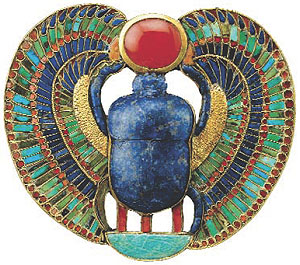Mother Nature's Masquerade
 King Tutankhamun's Inlaid Pectoral is just one of the items found in the boy king's tomb that is on display in a new traveling exhibit titled "Tutankhamun and the Golden Age of the Pharaohs." It features semiprecious stones like turquoise, which the ancient Egyptians associated with rebirth. Turquoise belongs to the copper carbonate family of minerals and was mined along with copper in the Sinai Desert during King Tut's reign.
King Tutankhamun's Inlaid Pectoral is just one of the items found in the boy king's tomb that is on display in a new traveling exhibit titled "Tutankhamun and the Golden Age of the Pharaohs." It features semiprecious stones like turquoise, which the ancient Egyptians associated with rebirth. Turquoise belongs to the copper carbonate family of minerals and was mined along with copper in the Sinai Desert during King Tut's reign. Photo credit: Andreas F. Voegelin, Antikenmuseum Basel and Sammlung Ludwig
High-resolution version of this photo.
While copper is known for its rich red-gold hue, it doesn't often appear that way in nature. Instead, it can be found masquerading in shades of blue, green, red and turquoise.
Thousands of years ago, the Egyptians learned that certain minerals contained valuable deposits of copper. These minerals include malachite (green), azurite (blue), cuprite (red) and turquoise (blue-green).
Malachite was especially prized because it could be easily melted down, or smelted, to obtain the copper. Turquoise, meanwhile, was mined for its own sake, as the Egyptians appreciated this natural gemstone's beauty and used it often in their jewelry.
The Egyptians also used ground, powdered copper to color religious, funerary and ornamental objects. The process, known as faience, involved glazing objects made from silica, a material found in desert sand, and firing them in a kiln. After firing, these pieces developed a shiny blue-green patina.
Small figurines were often made this way and placed in royal tombs as offerings. King Tut's tomb contained jewelry made using faience beads, as well as vessels and figurines in this blue color. Other notable examples of Egyptian faience are the brilliant blue wall tiles in the Step Pyramid and various necklaces and belts found in pyramid tombs.
Blue glass, which is also common in Egyptian jewelry and ornamentation, is made with copper. Examples of blue and green glass can be found as inlays on such precious objects as Tut's golden throne and his solid gold funerary mask, along with much of his jewelry. Cu
Resources:
Also in this Issue:
- A Golden Age That Never Ends
- The Dawn of a New Bronze Age
- Mother Nature's Masquerade
- New Generation of Artisans Discover Copper
